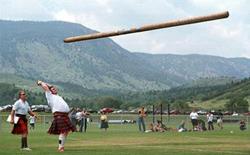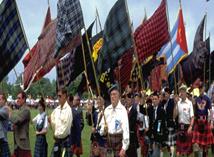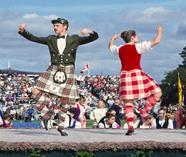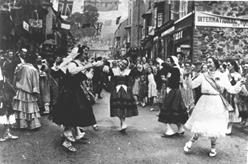Traditional British festivals
Highland games.



What are they?
Highland games are festivals held throughout the year in Scotland and many other countries of the world as a way of celebrating Scottish and Celtic culture and heritage, especially that of the Scottish Highlands. Almost all of the Games feature certain elements, such as the bagpipes, the kilt, and the heavy events, especially the caber toss, which are virtually emblematic of Scotland. While centered around competitions in piping and drumming, dancing, and Scottish heavy athletics, the games also include entertainment and exhibits related to other aspects of Scottish and Gaelic culture.
How it all started.
It is reported in numerous books and Highland games programs, that King Malcolm Canmore of Scotland, in the 11th century, summoned contestants to a foot race. Some have seen in this event the origin of today's modern Highland games. Following the repeal of the Act of Proscription, various Highland Societies, beginning in the 1780s, began to organize around attempts to retain or revive Highland traditions. It was these early efforts that eventually led to the Highland Games as we know them today. This modern revival of the Highland games received an enormous boost with the visit of King George IV to Scotland in 1822, although events were held in the years just prior to that. In 1819, for example, the St. Fillans Society organized a full scale Highland games with piping, dancing, and athletics and the Northern Meeting Society's Highland Games was first held in 1822. In the 1840s, in Braemar, Games began as a fund raising effort by local artisans to support a "Friendly Society" and their charitable activities. Soon thereafter, Queen Victoria who, together with her consort Prince Albert, had made Balmoral Castle their special retreat, began to patronize the Games. The Queen first attended the Braemar Games in 1848 and the following year, they were moved to the grounds of the Castle itself. Together with the earlier 1822 event, Queen Victoria's patronage of the Games constituted one of the most significant factors in the popularization of the Games and what some have called the Highlandification of Scotland.
Highland Olympics
In the latter part of the 19th century, the Highland games played a role in the development of the Olympic movement. As part of his efforts to organize the first games, Baron Pierre de Coubertin visited a number of athletic competitions in order to determine which sports should be included in the forthcoming Olympic Games, to standardize rules, and to examine the technical aspects of running such a competition. Among the events he visited for this purpose were a Highland Games event organized in conjunction with the Paris Exhibition of 1889. That event, in addition to what we today would call track and field events, also contained wrestling, tug-of-war, cycling, as well as competition in piping and dancing.
Events
In their original form many centuries ago, Highland games gatherings centered around athletic and sports competitions. Though other activities were always a part of the festivities, many today still consider that Highland athletics are what the games are all about - in short, that the athletics are the Games, and all the other activities are just entertainment. Regardless, it remains true today that the athletic competitions are at least an integral part of the events and one - the caber toss - has come to almost symbolize the Highland games. Although quite a range of events can be a part of the Highland athletics competition, a few have become standard: Caber toss, Stone put, Scottish hammer throw, Weight throw, Weight over the bar, Sheaf toss. Track and field events include a tug-of-war, kilted mile run and other foot races, shinty (a game somewhat like field hockey and dating back to the 18th century or earlier), and the stone carry.
Music
For many Highland games festival attendees, the most memorable of all the events at the games is the massing of the pipe bands. Normally held in conjunction with the opening and closing ceremonies of the games, as many as 20 or more pipe bands will march and play together. The result is a thunderous rendition of traditional favorites Scotland the Brave or Amazing Graze, and other crowd-pleasing favorites. It is, in fact, the music of the bagpipe which has come to symbolize music at the Games and, indeed, in Scotland itself. In addition to the massed bands, nearly all Highland games gatherings feature a wide range of piping and drumming competition, including solo piping and drumming, small group ensembles and, of course, the pipe bands themselves. But the pipes and drums are not the only music which can be heard at Highland games. Music at Highland games gatherings takes on a variety of forms. Many such events offer fiddling, harp circles, Celtic bands and other forms of musical entertainment, the latter usually spiced with a healthy amount of bagpipe music.
Dance
There are two basic forms of dancing at modern Highland Games gatherings. Scottish country dancing is a social dance like ballroom dancing or square dancing, the latter of which is related to Scottish country dancing. The other type of dancing which one can see at Highland Games events is the highly competitive and technical form known as Highland dancing. This again takes two forms. First there are the traditional Highland dances - the Sword Dance (or Gillie Calum), the Highland Fling, the Highland Reel, and the Seann Triubhas (pronounced shawn trews). The other class of competition dances are known as character and national dances, the most well known of which are the Scottish Lilt, the Flora MacDonald, the Earl of Errol, Highland Laddie, Blue Bonnets and Village Maid. Also common at the games are the Irish Jig, Irish step dancing, and the Sailor's Hornpipe dances. Highland dancing, in all its competitive forms, is a very technical dance form, requiring many hours of practice and training over a period of several years in order to perfect. In this respect, it has more in common with ballet than with the social dancing of the Scottish Country Dance. In addition, the Highland dances are typically performed solo, unlike country dancing. Even the Reel, which is performed with other dancers, is judged on an individual basis. Historically, the Highland dances were danced only by men. This came about as the result of the nature and origin of the dances themselves as well as the fact that during the years of Proscription, only military regiments were permitted to adopt Highland attire and practice the traditions such as dancing. But late in the 19th Century, a young woman named Jenny Douglas decided to enter a Highland dance competition. As this was not expressly forbidden, she was allowed to enter and since then, the number of females participating in the sport has increased until today in excess of 95% of all dancers are female.
Secondary events and attractions
At modern-day Highland Games events, a wide variety of other activities and events are generally available. The various clan societies make the Highland games one of the main foci of their seasonal activities. Visitors can find out information about their Scottish roots and can become active in their own clan society if they wish. In addition to the clan societies, Games visitors can usually find a number of other Scottish groups represented. A variety of informational booths, exhibits, and demonstrations can also be seen, especially at the larger games. This might include information on genealogy, the Gaelic language, exhibits on sheep shearing and weaving, and a variety of lectures on topics related to Scottish traditions.
Reconstructionist groups such as the Historic Highlanders and the SCA (Society for Creative Anachronism) can be found at some of the Games. These groups research Scottish history and attempt to recreate a picture of the life and habits, including garb, skills, culture and various items of times past, in the Scottish Highlands.
Merchant vendors are almost always a part of the games as well. The larger games will feature a wide assortment of such vendors offering such things as music recordings (bagpipe bands and groups, Scottish and Celtic entertainment groups), music equipment and supplies (bagpipes, drums, music scores, band equipment), books on a wide assortment of things Scottish, Celtic and Irish arts and crafts, and imports from Scotland and the United Kingdom, including an assortment of gift and souvenir items. And of course, there will be kiltmakers and vendors of tartan goods (kilts, blankets, ties, scarves) and kilt accessories.
Animals are also a part of many Highland games events, with Scottish terriers being perhaps the most familiar. Shelties and border collies can also be seen where many of the Games feature herding competitions involving sheep or geese. Highland cattle are also fairly common at the Games. This is a long haired, shaggy breed with sweeping horns especially adapted to harsh climates and sparse grazing conditions.
Finally, event visitors can sample a variety of specialty Scottish foods such as shortbread, bangers, meat pies, Irn-bru, scones, and haggis.
Essential vocabulary
heritage - наследие
to feature – отражать, показывать
the bagpipes – волынки
caber toss – метание бревна
to be centered around – концентрироваться вокруг
entertainment – развлечение
to summon – призывать, вызывать
repeal – запрет
Act of Proscription – Акт Разоружения (1 августа 1746г) после подавления англичанами восстания якобитов
to retain – сохранять
revival – возрождение
an enormous boost – невероятный подъем
prior – предшествующий
Braemar – Бремар (деревня в области Абердиншир в Шотландии)
a fund raising effort – попытка сбора средств
artisans – ремесленники
charitable activities – благотворительность
consort – супруг
to attend – посещать
to determine – определять
forthcoming – предстоящий
to run a competition – проводить состязание
in conjunction with – в связи с
track and field events – легкая атлетика
wrestling – борьба
tug-of-war – перетягивание каната
regardless – не смотря на это
an integral part – неотъемлемая часть
quite a range of events – значительная часть разнообразных состязаний
stone put – метание камня
hammer throw – метание молота
weight – вес (зд. тяжелый предмет)
over the bar – через барьер
sheaf – пучок (sheaf toss – метание соломы)
attendees – посетители
thunderous – громовое
rendition – исполнение
crowd-pleasing favorites – любимые народом мелодии
has come to symbolize – стала символизировать
fiddling – игра на скрипке
harp – арфа
spiced - приправленный
is judged on an individual basis – оценивается индивидуально
military regiment – военный полк
attire – одеяние
expressly forbidden – однозначно запрещено
to increase – повышаться
foci (sing. focus) – фокус
roots – корни
sheep shearing – стрижка овец
weaving – ткачество
garb – одеяние
vendors – торговцы
herd – стадо
shaggy – лохматый
sweeping horns – широкие рога
harsh climate – суровый климат
sparse grazing – редкие выпасы
shortbread – песочное печенье
bangers – сосиски
scones – булочки

Eisteddfod
An eisteddfod (Welsh: [ə(i)ˈstɛðvɔd]; plural eisteddfodau [ə(i)stɛðˈvɔdaɨ]) is a Welsh festival of literature, music and performance. The tradition of such a meeting of Welsh artists dates back to at least the 12th century, when a festival of poetry and music was held by Rhys ap Gruffydd of Deheubarth at his court in Cardigan in 1176 but, with the decline of the bardic tradition, it fell into abeyance. The present-day format owes much to an eighteenth-century revival arising out of a number of informal eisteddfodau. The closest English equivalent to eisteddfod is "session"; the word is formed from two Welsh morphemes: eistedd, meaning "sit", and bod, meaning "be".
The date of the first Eisteddfod is a matter of much debate among scholars, but boards for the judging of poetry definitely existed in Wales from at least as early as the twelfth century, and it is likely that the ancient Celtic bards had formalized ways of judging poetry as well. The first Eisteddfod can be traced back to 1176, under the auspices of Lord Rhys, at his castle in Cardigan. There he held a grand gathering to which were invited poets and musicians from all over the country. A chair at the Lord's table was awarded to the best poet and musician, a tradition that prevails in the modern day National Eisteddfod.
The earliest large scale Eisteddfod that can be proven beyond all doubt to have taken place, however, was the Carmarthen Eisteddfod, which took place in 1451. The next recorded large-scale eisteddfod was held in Caerwys in 1568. The prizes awarded were a miniature silver chair to the successful poet, a little silver crwth to the winning fiddler, a silver tongue to the best singer, and a tiny silver harp to the best harpist. Originally, the contests were limited to professional Welsh bards who were paid by the nobility. To ensure the highest standard possible, Elizabeth I of England commanded that the bards be examined and licensed. As interest in the Welsh arts declined, the standard of the main eisteddfod became more informal. In 1789, Thomas Jones organised an eisteddfod in Corwen where for the first time the public were admitted. The success of this event led to a revival of interest in Welsh literature and music. "The Gentleman's Magazine" of October, 1792 reported on the revival of the eisteddfod tradition. The first true National Eisteddfod organised by the Council was held in Denbigh in 1860 on a pattern that continues to the present day.
The most important eisteddfod is the National Eisteddfod of Wales, the largest festival of music and poetry in Europe. Its eight days of competitions and performances, entirely in the Welsh language, are staged annually in the first week of August, usually alternating between north and south Wales. Competitors typically number 6,000 or more, and overall attendances generally exceed 150,000 visitors.
Another important eisteddfod in the calendar is 'Eisteddfod Yr Urdd', or the Youth Eisteddfod. It involves Welsh youth aged 7 to 24 in a week of competition in singing, recitation, dancing, acting and musicianship during the summer half-term school holiday. The event is claimed to be Europe's premier youth arts festival.
The International Eisteddfod is held annually in Llangollen, Denbighshire each year in July. Choirs, singing groups, folk dancers and other groups attend from all over the world, sharing their national folk traditions in one of the world's great festivals of the arts. It was set up in 1947 and begins with a message of peace. In 2004, it was (unsuccessfully) nominated for the Nobel Peace Prize.
Smaller-scale local eisteddfodau are held throughout Wales. One of the best known is the Abergavenny Eisteddfod (Welsh: Eisteddfod Y Fenni). Schools hold eisteddfodau as competitions within the school: a popular time for this is on Saint David's Day.
Essential vocabulary
dates back to – уходит корнями
abeyance – состояние неопределенности
owes much to – многим обязан
scholars – ученые
boards – советы
under the auspices – под покровительством
crwth [ˈkruːθ] or [ˈkrʊθ] древний Валлийский струнный музыкальный инструмент
fiddler – скрипач
harpist – арфист
annually – ежегодно
alternating – чередуясь
attendances – посещения
to exceed – превышать
is claimed to be – претендует на звание
Guessing Game.
Split into two teams and take turns in answering questions. Get as many points as possible!
Ø What do the following Roman names refer to: Albion, Caledonia, Cambria, Hibernia?
Ø What nation has a prefix “Mac” or “Mc” in family names?
Ø What does this prefix mean?
Ø Give five examples of such family names.
Ø What nation has a prefix “O” in their family names?
Ø Guess what nations got the following nicknames: Jock, Paddy or Mick, Dai or Teffy.
Ø Name traditional Scottish clothes.
Ø Are kilts worn by women or by men only?
Ø What is Eisteddfod?
Ø What nation traditionally plays the bagpipe? The harp?
Ø What nation is known for their singing ability?
Ø What nation is believed to be “too careful with money”?
Ø What nation’s patron saints are St. George, St. Patric, St. David, St. Andrew? What can you remember about each of them?
Ø Name the plant-symbols of all the four nations.
Ø Describe the flags of all the four nations.
Ø What is the Union Jack?
Mark the questions that made both teams puzzled and find out the answers to them at home.
Match these historic events with their dates, putting them in the logical order and copy them into your notebook to remember.
| The Romans leave Britain | 55 BC |
| The Battle of Hastings | 43 AD |
| Edgar, grandson of Alfred, becomes king of all England | |
| England is attacked by the Vikings | |
| St Patrick converts Ireland to Christianity | |
| The Romans reside in Britain | |
| The whole of Wales is put under the control of the English monarch | |
| Julius Caesar lands in Britain, wins the battle and leaves | |
| St Augustine arrives in England |
